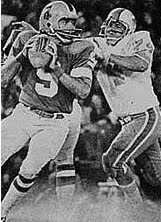
The World Football League kicked off its inaugural 20-week season with five games on July 10, 1974. The new league started off with 12 teams, along with great ambitions and several novelties. Most games were scheduled on Wednesday nights in order to avoid conflict with high school, college, and NFL games (a weekly nationally-televised game would be played on Thursdays). The July start (the league played no preseason games, although there were some intersquad scrimmages) gave the WFL a head start on the NFL, which was beset by a player’s strike during the preseason that kept veterans out of the training camps until late August.
The WFL instituted several rules changes, some of which the NFL had adopted for the ’74 season as well - they included moving the goal posts to the back of the end zone, allowing for an overtime period in case of ties, and bringing the ball back to the line of scrimmage if a field goal was missed outside the 20 yard line. While kickoffs in the NFL would now be from the 35 rather than 40 yard line, the WFL chose to kick off from the 30. Additionally, the new league banned fair catches of punts, allowed for forward motion by backs prior to the snap, required receivers to have just one foot in bounds for a catch to be legal, and prohibited the bumping of receivers beyond three yards of the line of scrimmage. Touchdowns would be seven, rather than six points, to be followed by an “action point” that could not be kicked. An invention called a “Dickerrod” was used instead of the traditional chains for measuring first down yardage.
There were 55,534 fans in JFK Stadium as the Philadelphia Bell hosted the Portland Storm, winning 33-8 behind QB Jim “King” Corcoran (pictured below left), who had the best passing night in the WFL’s first week. Corcoran, a semi-legendary figure in the world of minor league football, completed 21 of 38 passes for 227 yards and two touchdowns. The running tandem of Claude Watts (94 yards on 16 carries) and John Land (73 yards on 14 attempts) also had an impressive debut. WR Vince Papale, later to become celebrated as a walk-on free agent and special teams standout for the NFL’s Eagles, caught three passes for 39 yards.

Attendance at Orlando’s Tangerine Bowl was far less (18,625) as the Florida Blazers defeated The Hawaiians in a low-scoring 8-7 contest. RB Jim Strong was the star for the Blazers, catching a three-yard touchdown pass and then scoring the decisive action point. RB Derrick Williams gained 94 yards on 18 carries for The Hawaiians while Strong and fellow running backs Tommy Reamon and A.D. Whitfield combined for 104 yards for Florida. Blazers QB Bob Davis passed for only 55 yards and Norris Weese and Bill Donckers combined for just 106 yards for the Honolulu-based club.
A crowd of over 36,000 at Soldier Field saw the Chicago Fire record a 17-0 shutout of the visiting Houston Texans. QB Virgil Carter (pictured below right) threw two touchdown passes, although he also had three picked off. WR James Scott had 10 catches for 84 yards and one of the TDs. Houston ground out 116 yards rushing but veteran quarterbacks Don Trull and Mike Taliaferro passed for just 58 yards.

Legion Field in Birmingham was filled with 53,231 fans who saw the Birmingham Americans defeat the Southern California Sun by an 11-7 tally thanks to a 50-yard interception return for a touchdown by CB Steve Williams. RB Paul Robinson spurred the ground game with 79 of Birmingham’s 144 rushing yards although rookie RB Kermit Johnson of the Sun led all rushers with 88 yards on 24 attempts.
Elvis Presley was among 30,122 in attendance at the Liberty Bowl where the Memphis Southmen were winners over the Detroit Wheels, 34-15. Memphis RB J.J. Jennings (pictured at top) had the most rushing yards in the first week with 99, including a touchdown, and also caught four passes for 83 yards and another TD. Detroit WR Hubie Bryant had the best receiving game of the first week in defeat with 7 catches for 153 yards and a touchdown.
The following night, in the first nationally-televised contest with Commissioner Gary Davidson in attendance, the largest crowd of all, 59,112, was present at Jacksonville’s Gator Bowl as the Sharks defeated the New York Stars, 14-7. However, the game suffered a delay when a blown generator caused a blackout – it was perhaps a portent of bad things to come.
While the crowds were certainly encouraging, the scarcity of points was a disappointment. The league averaged just 13.8 points per game for the six contests. Scoring would improve as the season progressed, but other factors would cast a shadow over the WFL.
Several weeks into the season, it was divulged that attendance, particularly in Philadelphia and Jacksonville, had been considerably aided by the handing out of huge numbers of free tickets. Of the 55,534 fans at JFK Stadium, only 13,800 had actually paid; a crowd of 64,719 for the second home game, against New York, contained only 6200 paid attendees. The big opening night crowd at the Gator Bowl was padded by some 44,000 free passes.
League credibility never recovered from the disclosure, and the fact that the WFL was floating in a sea of red ink became clearer as the season progressed. By the end, 10 teams remained and two of those had relocated (Detroit and Jacksonville folded; the Houston Texans became the Shreveport Steamer and the Stars moved from New York to Charlotte, NC).
No comments:
Post a Comment